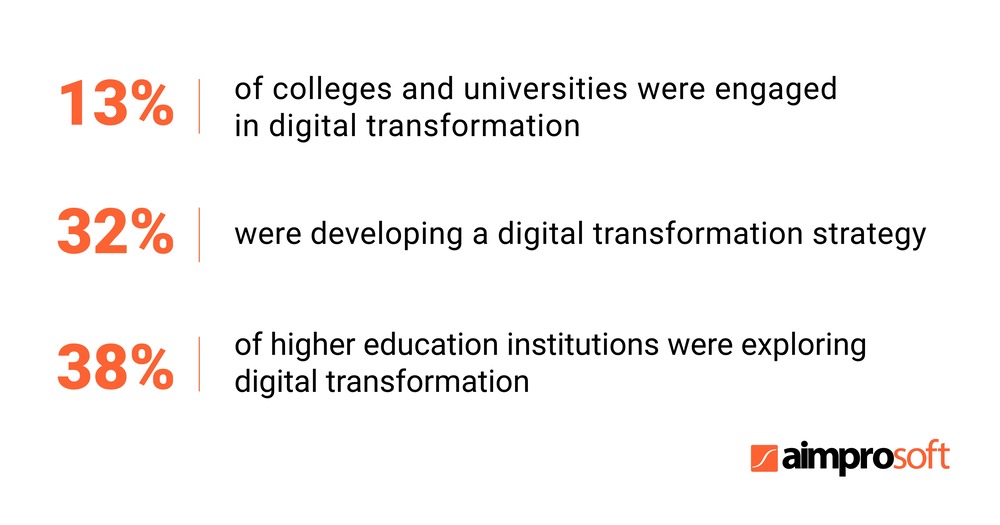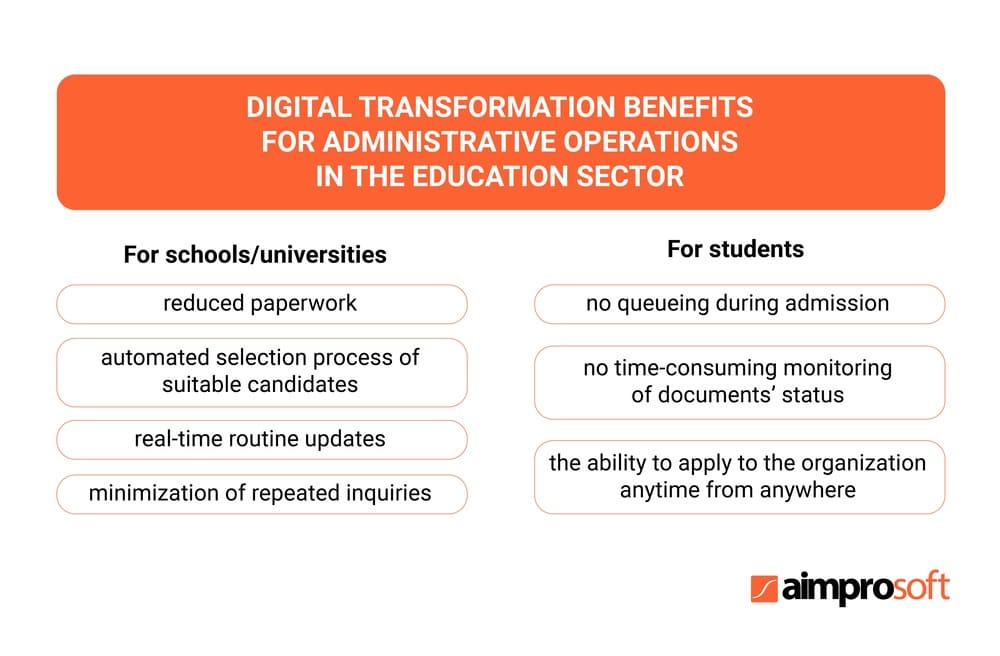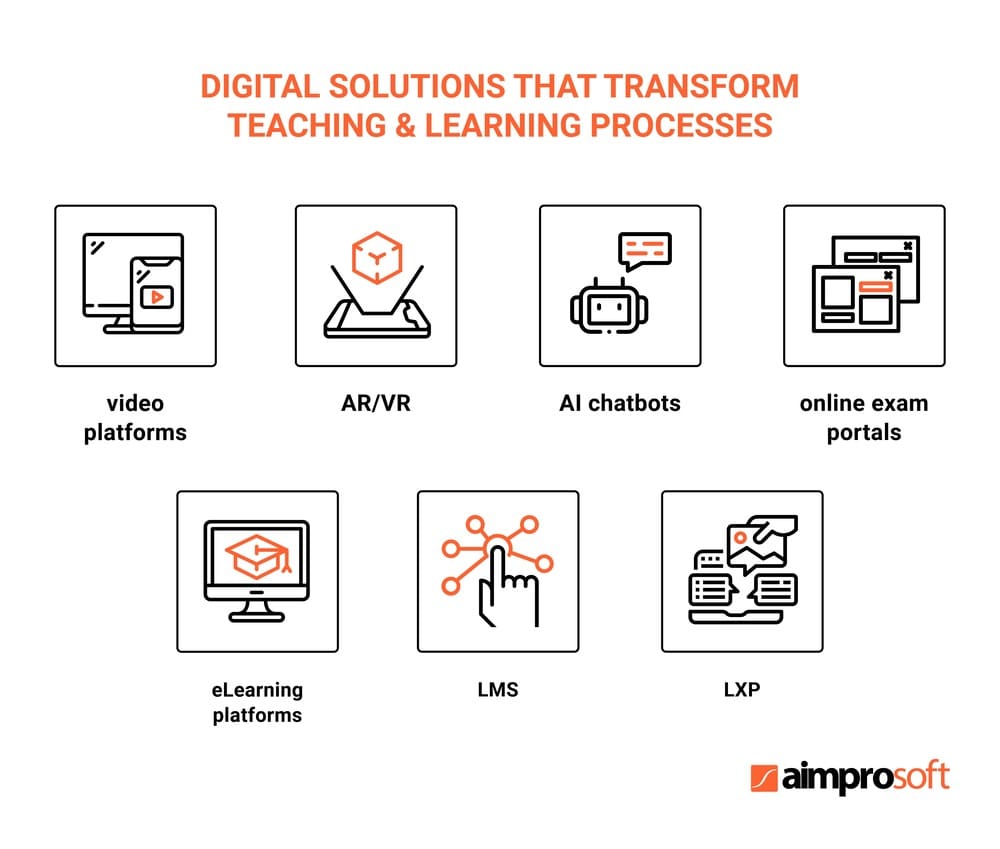Digital Transformation in the Education Sector

Key takeaways
-
Direct digital transformation (DX) investment spending is expected to reach $7.4 trillion between 2020 and 2023, which proves the trend of worldwide digitalization continues in different business sectors, including education.
-
Education institutions in over 190 countries have faced partial or full closure. To prevent any disruption of the learning process in the future, they ramp up their spending on digital technologies. For ex., China spent 29.9 bln topping the list of other countries that devoted their resources to ICT services in 2019.
-
Dig deeper into the main fields of digital transformation of the education sector to observe what you can gain in your organization.
-
Be aware of the possible DX challenges schools and universities go through to take preventive actions.
-
Constantly contributing to the education sector and digital transformation lets us gain experience in the development of diverse eLearning solutions. Read about some of them below.
What is digital transformation in education?
The term “digital transformation” had been overused so much that it seemed to lose its true value. However, the COVID-19 outbreak and its spread have brought into sharp focus digital transformation’s necessity as almost all the educational institutions had to apply it to one degree or another.
Closely working with clients from the education industry for 10+ years, we’ll break down this topic to separate the wheat from the chaff, help you define what your true organization’s needs are and how to approach the digital transformation process without extra spending.
Digital transformation in the education sector means enhancing its learning environment and administration system by applying new technologies. It allows reducing costs and meeting the growing demands of all the participants of your education process.
The industry has been rapidly applying DX since the COVID-19 outbreak, and as of 2020, we witness:

These trends don’t seem to disappear as schools and universities of all levels have realized the benefits of digital transformation technology in education.
Main fields of digital transformation in the education sector
Digital transformation is applicable in different fields of the education sector. Generally speaking, it can be divided into:
- administration;
- teaching and learning.
Administration
Digital transformation of a campus environment
During the pandemic times, all classes were moved to distance learning. Now the situation seems to get under control, and we witness that institutions from K-12 schools to universities gradually open their doors to learners. Nevertheless, in new pandemic circumstances, scholars require a certain degree of protection that becomes possible only with the adoption of new technologies:
Thermal screening
Let’s measure the temperature of students and teachers to combat the spread of the pandemic with the help of IoT.
Building an IoT app is not a simple task, but we claim that the sky is the limit. Learn how to create a secure IoT application
Regular sanitation
It is enabled by installing occupancy sensors that track the number of people visiting different campus areas to gauge the cleanliness of the facilities, streamline janitorial services at all times, and optimize the use of resources.
Social distancing control systems
Detects crowds with the help of cameras. Such systems’ software based on artificial intelligence can configure alerts to people responsible for controlling social distancing.
Contactless attendance systems
Another possible option to curb the spread of coronavirus is the implementation of contactless attendance systems. One of the most common ways of virus transmission is through surfaces, so the first point of contact and contamination threat occurs at a school or college doorstep. The contactless attendance systems vary from ID card scanning, attendance tracking systems with RFID (radio frequency transmitter and receiver) scanner to attendance trackers with face recognition generated through AI.
Face mask detection systems
They are used to relieve the administration from the duty to check everyone is wearing a face mask. With the help of CCTV systems, IP cameras, and AI, a setup detection solution can detect those without masks and send notifications to the authorized people to bring in measures.
Digital transformation of administrative operations
All educational institutions face such common problems as time-consuming student admission procedures, registration for programs and courses, curriculum planning, scheduling, teacher allocation, etc. All of these issues are effectively resolved now by the implementation of diverse software solutions aimed to reduce time, optimize labor and material spending on administration.
For example, to apply for admission, students have to wait in a queue and intermittently verify the submission status. The university/school administration also doesn’t stand aside: they are loaded with checking records, verifying qualifications, listing students, and updating their application status. The already mentioned software solutions make such processes available online for all education process participants — school/university administrations as well as students and their parents:

Teaching and learning
Online education trends have transformed existing teaching and learning processes into digital ones, and now we can see a wealth of handy solutions:
Video integration for online learning
It used to be Zoom, Skype, and Google Meet that helped conduct online lessons and even pass exams during COVID-19 pandemia. Now schools and universities can integrate these or any other video conferencing services when they start an eLearning website to ensure seamless real-time communication while learning remotely.
AR/VR technologies
Help enhance learning material perception and practical skills. How can pupils be carried away thousands of miles to see sand-hills of the Sahara Desert, or turn back time and be virtually present at Ancient Agora of Athens? Using headgears and VR glasses, students can get into a simulated environment for better acquisition of knowledge in Geography, History, or Biology.
Besides a traditional classroom, augmented reality and virtual reality can be used for interactive training purposes by medical institutions, military colleges, etc., without the actual risk to patients or learners. The only disadvantage of VR is its cost and content while AR is more accessible — possessing a mobile phone is enough for using it.
AI chatbots
Chatbots are another means of virtual teaching assistance. Due to time restraints and diverse duties, teachers are unable to answer all the queries, which doesn’t propel effective education. Chatbots can perform a range of tasks relieving teachers from this burden: answer routine questions students ask, provide feedback to learners, advise on more personalized content, monitor and analyze students’ learning skills and problem areas. If you build a website like Udemy, chatbots can play the role of virtual tutors supporting learners in their queries and reducing costs on personnel.
E-learning platforms, LMS, LXP, online exam portals, and other types of educational software solutions
The varied range of educational software provides both learners and teachers with all the necessary tools for effective learning while furthering the education process.
E-learning platforms
Their rich functionality enables course creation and management, student progress tracking, statistics, assignment attachment, video player, gamification, etc.
LMS (Learning Management System)
LMS, in its turn, is a powerful tool for teachers to manage their entire course from one centralized, secure environment putting stress on educational process assessment, grading, and collaboration. LMS implementation lets educational organizations get rid of a big chunk of administrative work — data collection, analysis, report creation, and management.
LXP (learning experience platform)
Unlike LMS with its predefined roadmap, LXP provides students with more personalized learning experiences by combining contents from different sources. LXP is a great shift from traditional ways of delivering content to highly personalized learning environments.
Online exam portals
Online exam portals (also known as test portals and exam systems) have become the most reasonable way to conduct tests since virtual classes became our new reality. By utilizing such portals, examiners reduce the time spent on exam preparation and administration. They are particularly convenient to use for learners, as usually they are web-based and don’t require downloading to take a test.

Benefits of digital transformation for education
Technologies are not only great savors for business but also great triggers of competition. Those educational institutions that have resources are the first that apply technologies and receive valuable benefits getting a competitive advantage in the long run:
-
They automate workflows in their organizations, so any process takes less time. Сonsequently, the internal processes are streamlined: vacation or sick day requests for staff, admissions, registrations, electronic signatures usage, etc.
Thinking about how to modify processes at your organization?Check a proven solution that intelligently automates any process
Learn more -
Such organizations save both on labor and materials (reduce paper usage, energy, and lighting consumption).
-
They take the education of the students to the next level.
-
Attract more students because anyone can apply distantly, study and pass exams online.
-
Possesses one storage place to easily locate and save files. It can be a cloud solution to allow access for users from any location or hybrid storage so that specified confidential information is entirely under their control.
-
Can get a competitive advantage by efficiently leveraging data. Digital transformation for education enables data analysis that gives a 360° vision of your students’ performance and teaching strategies, so you can quickly address any area of concern. With proper analytics, any institution is always in control.
-
Lastly, an easier and faster process of recruiting teachers digitally via a school/university website or third-party sources.
But what do other participants of the education process gain? Students are the prime cause of all digital transformation efforts organizations take. And it is justified by the results that you can see below. In their turn, educators move to the new level of teaching and material feed enabled by DX:
| DX benefits for students | DX benefits for educators |
|---|---|
| 1. Improved student experience because of organizations’ processes automation: they take admissions, register for courses distantly via the Internet. Can do it even from their mobiles if you make an education app. | 1. Teachers are released from an administrative burden. Now they dedicate more time to educational materials and methodologies preparation to upgrade learning instead of wasting time on administrative issues. |
| 2. Everyone perceives the same material differently at a different pace. So personalized learning approach enabled by digital transformation in schools lets scholars absorb knowledge with maximum effectiveness that leads to high student retention rates. | 2. Educators possess a deeper and more realistic insight on students’ results and understand who needs attention, so can improve students’ knowledge and results accordingly. |
| 3. Students get a higher quality of education thanks to AR/VR that eases the explanation process and helps learners concentrate by excluding any side stimuli. Personalized approach to learning, quick answers to the questions, and necessary information delivered by a chatbot — all of that students get with AI introduction to the education sector. Availability of checked and secured material 24/7 has been made possible with cloud technologies. | 3. Enhanced learning due to EdTech advancements. EdTech is a broad term that embraces the modern devices (whiteboards, tablets, projectors, cameras, etc.) and software (online learning platforms, AI, AR/VR, chatbots, websites, portals, etc.) applicable to facilitate learning. Because schools and universities have already utilized EdTech to some degree, teachers have tools to engage students in the learning process, provide more interesting and sophisticated material, speed up learning, save time on different management processes. |
| 4. All of us strive for the personal safety and safety of our children. Not so long ago, only a security guard or campus security officer could provide protection. With such digital transformation technology in education as IoT, educational institutions can approach children’s safety at every nook and cranny via camera usage, face recognition technologies, sensors that track traffic throughout school/university facilities. | 4. Effective education through collaboration. Teachers can build and manage groups in a digital collaboration environment through learning platforms so that users share materials, exchange important information in any format (text, video, audio), start discussions, and answer questions. |
| 5. Accessibility to schools, lessons, different programs for disabled students with visual, audio impairments, reading disabilities, and for those who are remotely located from the point of destination. |
The education industry unquestionably benefits from DX. But what does it lay in the path of digital transformation in the education industry successful implementation?
Possible challenges of digital transformation of the education sector
Forewarned is forearmed is an old saying, but it remains relevant to this day. Before implementing digital transformation for education, you should be aware of the complexities that may come your way. Don’t step on a rake as others do; read the possible challenges to avoid them in your organization:
Undefined strategy
What can it lead to? Digital transformation is a broad concept, so you should ask yourself what it holds specifically to your organization. If you don’t have an insight into the state of your current processes and operations, you can’t identify the organization’s gaps and resources; therefore, form a solid strategy, which is usually a cause of the digital disruption.
What can you do to change the situation? Answer the following 3 questions to map up the state of your processes and operations. With their help, you can identify priorities and mitigate risks of digital transformation stall in the future:
- Where do you want to be?
- Where are you now?
- What should be done to get there?
That will allow you to exercise strategic decisions with speed and precision. Then you can follow the steps to craft a winning digital transformation strategy for education:
- Assess your current state: it will give you information about your digital processes and resources.
- Identify your goals and desired outcomes.
- Share the vision of digital transformation necessity with all key players in the organization.
- Decide how many funds you can allocate for digital transformation services in education. Be aware that it’s not a one-time project, and as life goes on, you’ll need to make investments to upgrade your processes.
- Create a strategic roadmap with measurable goals for each milestone and for a long perspective.
Learn how we can help you
Learn moreResistance to change
What can it lead to? If the way people perform their duties at workplaces doesn’t cause major difficulties, they would be reluctant to get out of their comfort zone. Changes cause resistance, so employees may derail your bold plans, slow growth, and development.
What can you do to change the situation? You should get buy-in throughout the organization. In other words, communicate the value of digital transformation from top to bottom. For that:
- Conduct presentations and prepare materials to share on social media or the company’s trusted sources to accustom people with your plans of transformation.
- Step by step, convey the value employees will receive through digital transformation: how they’ll improve their education quality, reduce routine at work and simplify their processes.
Lack of digital skills
What can it lead to? A total of 8.6 mln people across the European Union and the United Kingdom lack digital skills. Their shortage is another cause why people may hinder digital transformation in the education sector.
What can you do to change the situation? Show the employees how you are going to overcome the digital skill gap in your organization to enable them to use innovative digital tools and applications. That, of course, requires the plan of upgrading your employees’ technical knowledge and skills in easily digestible chunks.
Data silos
What can it lead to? Different educational stakeholders and departments use different software solutions and tools, i.e., spreadsheets, accounting software, CRM, or others. Often they are legacy systems that do not easily share information. Moreover, each solution stores and manages data in a different way, which again gets in the way of successful data sharing.
If such valuable data as students’ admissions, acceptance rates, degrees completed, website engagement, etc. is not accumulated, processed, and analyzed in one place, you can’t provide more qualitative education to them and finally make weighed strategy decisions.
What can you do to change the situation?
- First of all, analyze what data benefits your organization most to provide handy insights on all business processes.
- Define what metrics you don’t need and sift out inessential data.
- By consulting your IT department or a hired educational software developer, choose the tools to organize and analyze data correctly before moving it to a central data repository.
Systems incompatibility
What can it lead to? Many systems already adopted by your educational institution cannot be compatible with innovative solutions set forward by the digital transformation initiative. The integrated systems you put much money into will not work well with each other and can end up in a mismatched system across the institution. Such disjoined systems cause data silos that would block getting valuable insight into the organization’s operations and just postpone for a while further need of system integration.
What can you do to change the situation?
- Definitely, systems compatibility should be thought over in advance but can be a complex task without proper expertise. Consultation with a professional software vendor will be a wise decision to escape mistakes and further risks.
- Define infrastructure budgets to make the decision on affordable changes, replacements, and customizations.
Start your digital transformation in education with Aimprosoft
Aimprosoft has been accelerating digital transformation in the education sector by delivering development services for 10+ years. That allowed us to build a wide range of solutions for our clients.
We take professional pride in a created learning platform that helps post-secondary students search for the jobs of their dreams. In parallel, it offers instant access to skill development opportunities and hands-on learning.
By registering on the platform, universities provide their students with career opportunities and map their WIL (Work-Integrated Learning) types and fields of study, while businesses gain direct access to a mass of students at post-secondary institutions with relevant skills and talents fundamental for future business profitability and success.
It was a platform with a complicated structure that consisted of multiple modules and rich functionality. We are glad that the efforts we put into that solution have resulted in a robust product that allows students to find the job of their dream. And it’s become a hub for all the education and business sector participants to intersect in one place for meaningful educational, career, and business opportunities.
We’ve also helped businesses with the development of LMSs that ensure seamless monitoring of employees’ learning processes, courses completion, result assessments, making sure staff is familiar with the company’s updates, and upgrade their knowledge level to the field requirements. We’ve developed such software from scratch, but we also can customize the existing solutions to your specific requirements. For instance, for one of our cases, we’ve built an LMS on the basis of an open source Moodle platform.
Another case of a successful education project was a cross-platform math learning app for children of different age categories. Since tutoring is very expensive in the country of our client’s origin, such an affordable product allows children from different backgrounds to greatly improve their knowledge of math.
The app differs from the other analogous solutions by the extended functionality, including integration of the parental portal to track the children’s progress, precise analytics of the user journey, math exercise builder developed specifically by our software engineers to simplify exercise creation, offline content storage, integrated payment system, gamification, and others. Making a learning language app was also a profitable solution you can read about in our blog.
We mentioned just a few of our educational projects. The list goes on.
If you want to learn more about how we work with the education sector and what can do particularly for your organization, talk to our development specialists
Conclusion
What we see today is clear evidence that even though schools and universities are gradually returning to brick-and-mortar education, this approach is no longer dominant. First of all, the learners are reluctant to attend physical premises, approaching the benefits of distance learning. Secondly, technologies provide new capabilities to education processes. In the near future, physical classes will remain but will undergo further transformation. Now we are at the dawn of it all, but as innovations are rapidly evolving, there’s no way to stay aside to beat off the competition. If you are hesitant about what to begin from or have an idea you want to talk about, contact us to start your digital transformation journey.
FAQ
From what to start the digital transformation in schools or universities?
First of all, establish exactly what DX means to your organization. For this, evaluate how your organization is currently operating, what holds you back, your challenges, digital capabilities, stakeholders, competition, and the industry itself. Such analysis will help you escape either over or under-transforming.
Set an objective of digital transformation. No less important getting your project off the ground to obtain the buy-in of your plan across an organization. From this point, you may turn to a software development partner that can help you form a digital transformation strategy for education on the basis of the received knowledge. If such a company offers full cycle development digital transformation services in education, they can assist you from the stage of business analysis to the educational solution support.
What are the main challenges that may block the path to digital transformation in my organization?
The first problem you may encounter is an absence of a common vision on what is needed in terms of digital transformation for your organization. That’s why there’s so much talk about buy-in in the organizations. Another blocker can be a lack of an up-to-date strategic view. Resistance to change, lack of digital skills are other social issues most likely you will have to overcome. Data silos and systems incompatibility are the major technical issues that should be taken into consideration in advance by the software company you partner with.
Why do some digital transformation in the education industry projects fail, and how to prevent such a situation?
Actually, it is rare when the cause of DX failure or stall has technical roots. In most cases, it is a cultural problem that may embrace a lack of shared vision on the needed improvements, poor planning, and unclear strategies. To prevent it, you should carefully assess the current organization’s state: current processes, operations, organization’s structure, existing pain points, and workforce’s skill set. When you’ve got a clear vision, it’s easier to sell it to the rest of an organization.
Forming a winning strategy for what is digital educational transformation may also be a complicated task, so the solution may lay in hiring a software vendor who will professionally conduct a business analysis (BA) and, on its basis will be able to build a clear strategy with project roadmap, timelines, clear technical requirements, and justified budget. As the technical specialists carefully approach the choice of the best-fit technologies for your digital transformation in the education industry project, arising challenges can be overcome, and they are the responsibility of the vendor who is obliged to remove and fix them.











